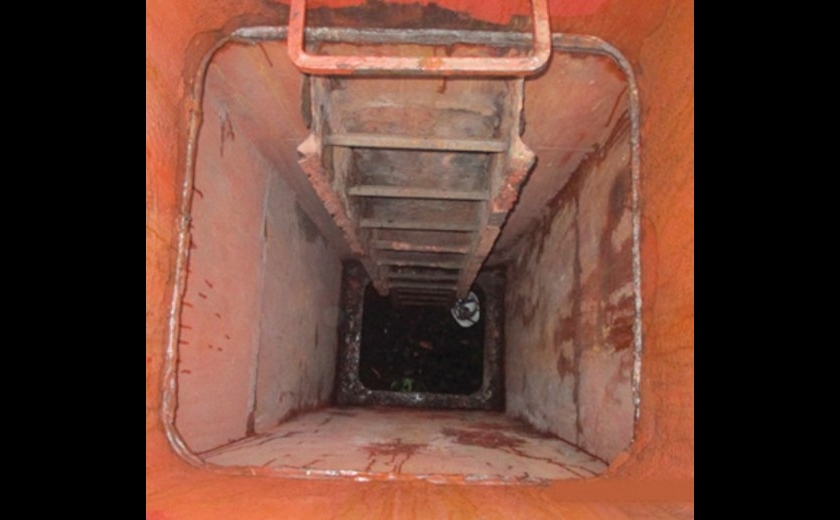Every year, crew members die as a result of entering an enclosed space with less than adequate oxygen levels. In its latest Mars Report, The Nautical Institute describes another such a sad incident. The institute’s advice on prevention: training and awareness.
The Nautical Institute gathers reports of maritime accidents and near-misses. It then publishes these so-called Mars Reports (anonymously) to prevent other accidents from happening. A summary of this incident:
A bulk carrier loaded with coal was at berth and crew were preparing to discharge. The bosun, fitter, and deck cadet were to open all the cargo hold hatch covers. After the hatch cover for cargo hold 1 was opened, the fitter told the Bosun that he needed to enter the access way to hold 1 to retrieve an air nozzle which he had dropped while clearing the hatch coaming at the previous port.
The bosun and fitter opened the aft access hatch to cargo hold 1, but the bosun told the fitter to wait at least twenty minutes before entering. Some time later, the deck cadet walked by the cargo hold and looked into the open hatch. He saw the fitter lying motionless below on the coal close to the access ladder. He immediately notified the bosun using his portable radio. The bosun quickly arrived on scene and, without raising the alarm, went directly down the access ladder in an attempt to rescue the fitter. Shortly after entering the cargo hold, the bosun lost consciousness.
The chief officer heard the deck cadet’s radio transmission and went to the access hatch. He immediately recognised the need to carry out an enclosed space rescue. The alarm was raised and crew members assembled and donned breathing gear. The two victims were extricated; the bosun regained consciousness after being brought on deck, but the fitter was not breathing and had no pulse. Despite resuscitation efforts, the fitter was pronounced deceased at a local hospital.
Also read: Crew member dies in enclosed space after deadly H2S goes undetected
Investigation findings
Among other things, the investigation found that:
- The company’s enclosed space entry procedures were not followed. In particular, the ship’s officers had not been notified of the need or intention to enter the hold. The first, failed, attempt to rescue the fitter without initiating the enclosed space rescue procedures was a grave error that not only delayed the recovery of the fitter, but put the bosun’s own life in danger.
- There was a distinct lack of awareness on the part of certain crew members on the hazards of entering a cargo hold containing coal without first complying with the company’s enclosed space entry procedures.
Some of the initiatives taken after the investigation:
- Locking devices were fitted to the access hatches for all cargo holds and other enclosed spaces on board the vessel.
- The company’s safety management system (SMS) was updated to require permanent signs at the entrance to enclosed spaces warning of the risk of asphyxiation if entered without taking proper precautions.
- A training initiative was implemented to increase awareness of the hazards of entering enclosed spaces without taking proper precautions.
Also read: Never rush into a space that has a collapsed crew member inside
Advice from The Nautical Institute
- Signs are not enough! Many vessels now routinely have signage posted at the cargo hold access hatches that prohibit entry unless the enclosed space entry procedure is followed. Yet, year after year, crew are still dying in cargo holds with less than adequate oxygen or the presence of other gases that do not support life.
- Locking devices on cargo hold access hatches are one way to mitigate risks of unauthorised entry, but the best protection is training and awareness of the risks. A cargo hold and its associated access ways are enclosed spaces.
- Pre-identifying all enclosed spaces on a vessel and posting a reminder at the entrance to each space can be considered a best practice.
Also read: Enclosed space claims another victim
Mars Reports
This accident was covered in the Mars Reports, originally published as Mars 202237, that are part of Report Number 359. A selection of this Mars Report was also published in SWZ|Maritime’s October 2022 issue. The Nautical Institute compiles these reports to help prevent maritime accidents. That is why they are also published (in full) on SWZ|Maritime’s website.
More reports are needed to keep the scheme interesting and informative. All reports are read only by the Mars coordinator and are treated in the strictest confidence. To submit a report, please use the Mars report form.








